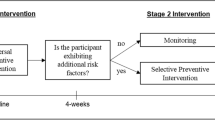Abstract
Continued public support for the design, implementation, and dissemination of preventive interventions depends on achievement of four major criteria: (a) Reductions in the incidence or prevalence rates of diagnosable emotional and behavioral disorders, (b) reductions in the need for mental health services through effective primary and secondary interventions, (c) enhancement of the effectiveness of obtained services as screening and early detection efforts are implemented, and (d) reductions in the nation's health care costs associated with emotional and behavioral dysfunctions. Strategies including risk reduction, risk avoidance, health promotion, empowerment, and resource development are preventive insofar as they contribute to achievement of the aforementioned outcomes.
Similar content being viewed by others
References
Albee, G. W. (1982). Preventing psychopathology and promoting human potential.American Psychologist, 37, 1043–1050.
Albee, G. W. (1986). Advocates and adversaries of prevention. In M. Kessler and S. E. Goldston (Eds.),A decade of progress in primary prevention. Hanover, NH: University Press of New England, pp. 309–332.
Caplan, G. (1964).The principles of preventive psychiatry. New York: Basic Books.
Cowen, E. L. (1973). Social and community interventions.Annual Review or Psychology, 24, 423–472.
Cowen, E. L. (1986). Primary prevention in mental health: Ten years of retrospect and ten years of prospect. In M. Kessler and S. E. Goldston (Eds.)A decade of progress in primary prevention. Hanover, NH: University Press of New England, pp. 3–46.
Department of Health and Human Services (1991).Healthy People 2000: National Health Promotion and Disease Prevention Objectives. DHHS Publication No. (PHS) 91-50212. U.S. Government Printing Office: Washington, DC.
Eisenberg, L. (1989). Public policy: Risk factor or remedy? In D. Shaffer, I. Philips, and N. B. Enzer (Eds.),Prevention of mental disorders, alcohol and other drug use in children and adolescents. OSAP Prevention Monograph-2 (DHHS Publication No. ADM 89-1646). Washington, D.C: U.S. Government Printing Office, pp. 125–156.
Flay, B. R. (1986). Efficacy and effectiveness trials (and other phases of research) in the development of health promotion programs.Preventive Medicine, 15, 451–474.
Harwood, H. J., Napolitana, D. M., Kristiansen, P. L., & Collins, J. J. (1984).Economic costs to society of alcohol and drug abuse and mental illness: 1980. Research Triangle Park, NC: Research Triangle Institute.
Kellam, S. G., Werthamer-Larsson, L., Dolan, L. J., Brown, C. H., Mayer, L. S., Rebok, G. W., Anthony, J. C., Laudoff, J., Edelsohn, G., & Wheeler, L. (1991). Developmental epidemiologically based preventive trials: Baseline modeling of early target behaviors and depressive symptoms.American Journal of Community Psychology, 19, 563–584.
Kessler, M., & Albee, G. W. (1977) An overview of the literature of primary prevention. In G. W. Albee and J. M. Joffe (Eds.),The issues: An overview of primary prevention. Hanover, NH: University Press of New England, pp. 351–399.
Klein, D. C., & Goldston, S. E. (Eds.) (1977).Primary prevention: An idea whose time has come. Washington, D.C. U.S. Government Printing Office.
Kuhn, T. S. (1970).The structure of scientific revolutions. Chicago, IL: The University of Chicago Press.
Lorion, R. P. (Ed.) (1990).Protecting the children: Strategies for optimizing emotional and behavioral development. New York: The Haworth Press.
Lorion, R. P., & Ross J. G. (Eds.) (1992). Programs for change: Office for Substance Abuse Prevention demonstration models.Journal of Community Psychology (Special issue).
Lorion, R. P., Price, R. H., & Eaton, W. W. (1989). The prevention of child and adolescent disorders: From theory to research. In D. Shaffer, I. Philips, and N. B. Enzer (Eds.),Prevention of mental disorders, alcohol and other drug use in children and adolescents. OSAP Prevention Monograph-2 (DHHS Publication No. ADM 89-1646). Washington, B.C.: U.S. Government Printing Office, pp. 55–96.
Lorion, R. P., Myers, T. G., Bartels, C., & Dennis, A. (1994). Preventive intervention research: Pathways for extending knowledge of child/adolescent health and pathology. In T. Ollendick and R. Prinz (Eds.),Advances in Clinical Child Psychology (Vol. 16). pp. 109–140. New York: Plenum Publishing Co.
Meinert, C. L. (1986).Clinical trials: Design, conduct, analysis. New York: Oxford University Press.
National Mental Health Association (1986).The prevention of mental-emotional disabilities: Report of the National Mental Health Association Commission on the Prevention of Mental-Emotional Disabilities (Vols. I & II). Washington, D.C.: National Mental Health Association.
Price, R. H., Cowen, E. L., Lorion, R. P., & Ramos-McKay, J. (Eds.) (1988).14 ounces of prevention: A casebook for practitioners, Washington, C.C.: American Psychological Association.
Roberts, M. C., & Peterson, L. (Eds.) (1984).Prevention of problems in childhood: Psychological research and applications. New York: Wiley-Interscience.
Sameroff, A. J., & Fiese, B. H. (1989). Conceptual issues in prevention. In D. Shaffer, 1. Philips, and N. B. Enzer (Eds.),Prevention of mental disorders, alcohol and other drug use in children and adolescents. OSAP Prevention Monograph-2 (DHHS Publication No. ADM 89-1646). Washington, D.C.: U.S. Government Printing Office, pp. 23–53.
Shadish, W. R. (1990). What can we learn about problems in community research by comparing it with program evaluation? In P. Tolan, C. Keys, F. Chertok, and L. Jason (Eds.),Researching community psychology: Issues of theory and methods. Washington, D.C.: American Psychological Association, pp. 214–223.
Author information
Authors and Affiliations
Rights and permissions
About this article
Cite this article
Lorion, R.P. Counting the stitches that count: Preventive intervention promises and public health. Am J Commun Psychol 21, 673–679 (1993). https://doi.org/10.1007/BF00942177
Issue Date:
DOI: https://doi.org/10.1007/BF00942177




